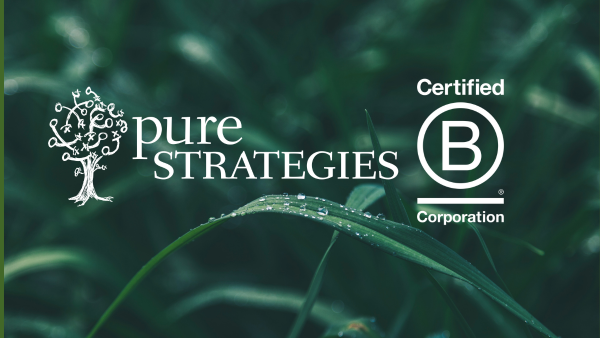By 2050, our global population will grow by more than 2 billion, which will require 70 percent more food. In addition to rising demand, companies are facing increasing scrutiny on the environmental impacts across their value chains. While improvements in processing and packaging are helping brands progress on sustainability, interventions at farm level are essential for driving real change.
We recently spoke with Pure Strategies’ Co-Founder and Managing Director, Tim Greiner, to learn more about how brands and farmers both are working together to usher the industry towards a more sustainable future.
Why is the need for a sustainable food and agriculture system so pressing?
Tim Greiner: Population growth and affluence are driving the need for sustainable food. By 2050, there will be 9.5 billion people on the planet, more than triple the number when I was born in 1961. And as countries develop, their people want to eat the protein-rich diets enjoyed by more developed countries. Food and agriculture are already leading sources of greenhouse gas emissions and a primary driver of water use globally.
What are some trends that you are watching closely?
TG: There is a lot going on in agriculture today. We see producers focusing on increasing yields, improving animal care, and reducing the toxicity of pesticides. The pollinator protection movement is fascinating: Mondelez, the world’s largest snack company, buys wheat from farmers who agree to advanced agricultural practices, including setting aside 3 percent of their land for cultivation of plants known to attract butterflies and bees. The movement to help farmers transition to organic bears watching as well: Kashi, General Mills and Organic Valley support farmers in transitioning land to organic production. In fact, the USDA and Organic Trade Association launched a new certification for farms in transition to organic. But perhaps the most dynamic trend is the new focus on soil health and carbon sequestration.
Let’s talk about the emphasis on healthy soils.
TG: I am seeing an explosion of interest in this area. Healthy soils are more productive, retain water better, and improve yield. Yet there is more to the story. When viewed as part of an ecosystem, healthy soils can also sequester carbon. Cutting-edge companies such as Organic Valley see healthy soils as an ecosystem solution, with cows playing a critical role.
Can you give an example?
TG: Sure. Brent and Regina Beidler began farming in Randolf Center, Vermont in 1998, taking over a conventional farm. They wanted a grazing farm and started with a goal of maximizing the grass their cows ate. They transitioned the farm to organic in 2001 and joined the Organic Valley Coop. By 2005, their herd had become 100 percent grass fed and they were 100 percent self-sufficient in that they were growing all the food for their animals. Brent says this system worked really well for them and the cows. The farm finances stabilized and the cow were healthier. Vet bills were and continue to be negligible. A few years back, studies started showing the benefits of Omega-3 fatty acids in grass-fed milk. Brent told me, “That kept us on the 100 percent grass forage diet. When your family is drinking the milk, it’s hard to move away.”
Brent and Regina also rotational graze their cows, giving them a new paddock of grass every 12 hours. They adjust the paddock size according to height and thickness of the grass and won’t return to an area until the grass is rested and regrown – in roughly 25 or 30 days. These practices have led to a doubling in the organic matter in the soil – from 3-4 percent to 6-8 percent. A good part of that is carbon now sequestered in the soil.
Brent says grazing his animals “opens up a different part of our brain. We started doing pasture walks and learning more about our animals.”
What other brands are leading the way in agriculture?
TG: AB InBev’s Smart Barley program provides farmers with valuable benchmarking data and technical support. When you drink a Budweiser, think about the barley producer who is optimizing water use on their farm. General Mills has ambitious goals to source its top 10 commodities sustainably by 2020. Smithfield is seen as a conventional company but has been doing some interesting things, pushing the boundaries of sustainable agriculture in animal proteins. They were the first to report antibiotics use publicly and one of the first to go upstream to get feed producers to reduce their environmental impacts. And Dannon has created a new model where they are directly sourcing milk and are applying sustainability requirements to this process.
Ben & Jerry’s Caring DairyTM program stands out for its comprehensive approach. The program covers farmer livelihoods, farm worker livelihoods, animal welfare and environmental outcomes. In the environmental arena, the program rewards farmers that build soil health, reduce fertilizer runoff, reduce greenhouse gas emissions, and minimize toxic pesticide use. It’s a continuous improvement program that includes benchmarking, training and financial support. It’s one of the premier producer-engagement programs in the dairy industry.
What technologies and tools are you seeing these companies employ?
TG: The agricultural community is brimming with tech, from drones, precision technologies, satellite imaging, robots, etc. The opportunities are mind blowing and provide farmers with insights to optimize inputs like water, fertilizer, and pesticides, enhance sustainability, save money, and improve yield. Greenhouse gas emissions are being tracked more comprehensively than ever before, through tools such as Field to Market (used by General Mills), COMET (used by Ben & Jerry’s) and FarmSmart (used by many dairy companies).
What does regenerative agriculture mean to you?
TG: Regenerative agriculture is an evolving area. It describes a set of practices that build soil organic matter, sequester carbon and restore soil health. It includes a focus on many of the practices we’ve discussed, including managed intensive rotational grazing, pasture cropping, no-till and compost. There is quite a bit of energy around regenerative agriculture, particularly in the organic and small-scale agriculture communities.
What are some of the big questions that capture where sustainable agriculture may be headed?
TG: There are two really big questions the industry will be focusing on over the next 5-10 years. First, can you have carbon-positive food production? While this seems possible, it will be challenging and will require leveraging best practices, innovations and new technology. Second, should we be shifting food consumption to things that have less impact? We all know animal proteins (beef, dairy, chicken, pork, fish, etc) have much higher impacts that a plant-based diet. But will we see significant consumer shift in this direction over the next decade?
This article originally appeared in Sustainable Brands.


